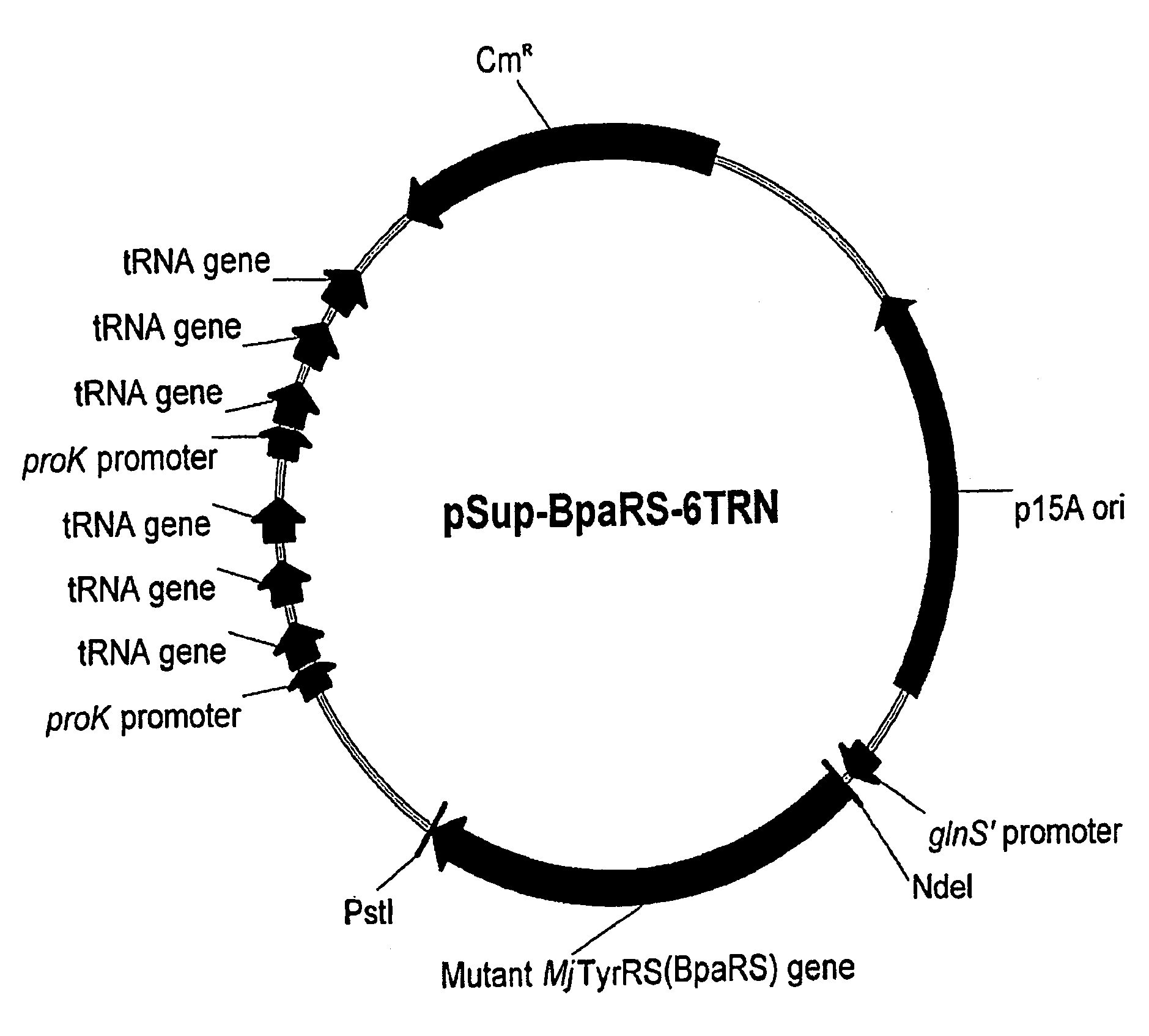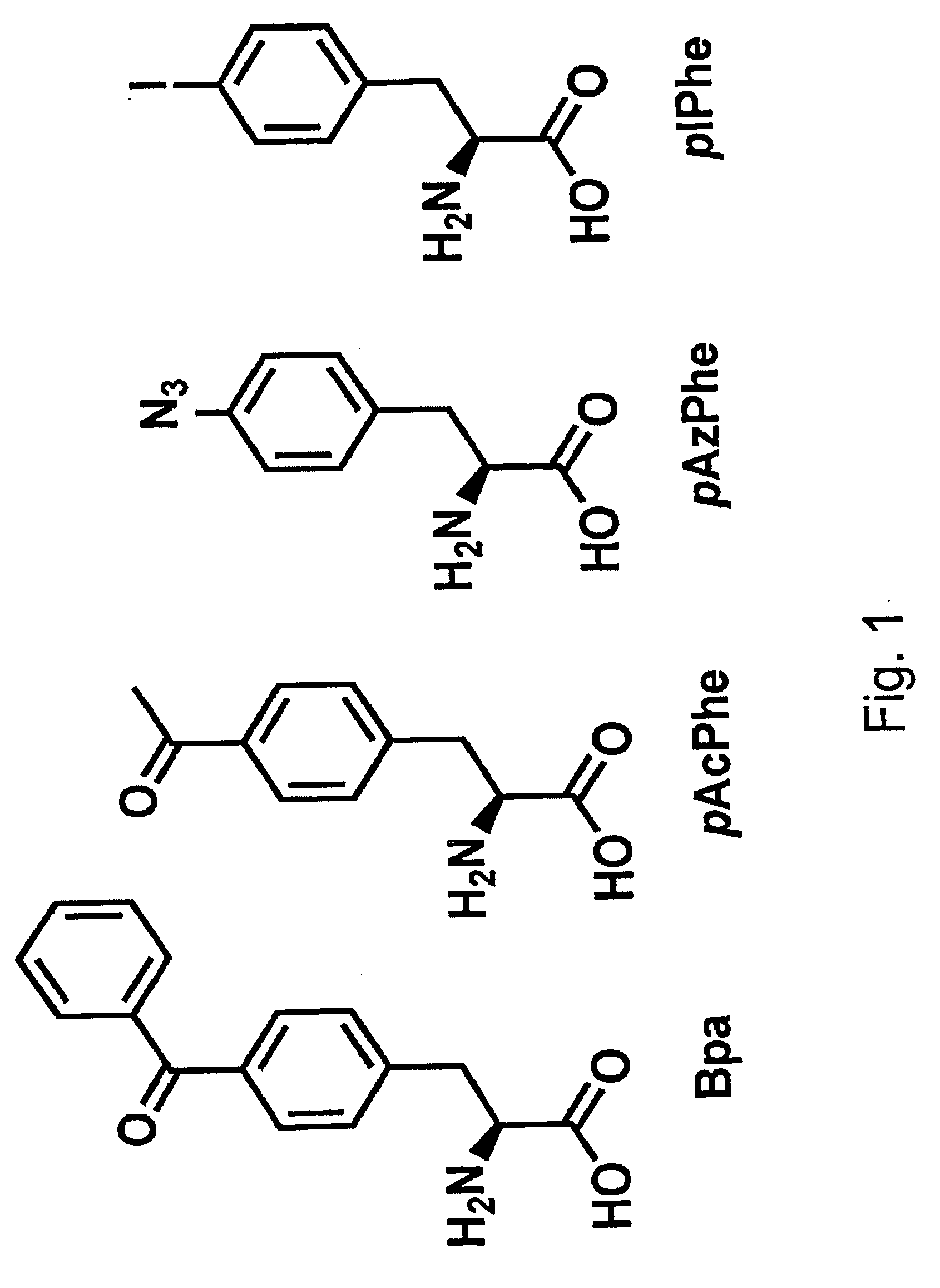Systems for the Expression of Orthogonal Translation Components Eubacterial Host Cells
a technology of orthogonal translation components and host cells, applied in the field of protein chemistry, can solve the problems of poor suppression efficiency of the orthogonal system to overcome the selector codon, the efficiency of the expression system for the production of mutant proteins containing unnatural amino acids is not optimized, and the study of protein structure and function is restricted. , to achieve the effect of improving the efficiency of incorporation of unnatural amino acids
- Summary
- Abstract
- Description
- Claims
- Application Information
AI Technical Summary
Benefits of technology
Problems solved by technology
Method used
Image
Examples
example 1
The Construction of a Single-Plasmid System for the Expression of Polypeptides Comprising Unnatural Amino Acids
[0307]The present Example describes the construction of a plasmid encoding both members of an orthogonal aminoacyl-tRNA and aminoacyl-tRNA synthetase pair for the incorporation of p-benzoyl-L-phenylalanine.
[0308]A plasmid was constructed (called pYR-BpaRS1) containing nucleotide sequences that encode both components of an orthogonal translation pair that function in an E. coli host cell. Namely, these two components are the orthogonal tRNA MjtRNA-Tyr(CUA) and the mutant MjTyrRS synthetase (BpaRS) that specifically aminoacylates the orthogonal tRNA with the photocrosslinking amino acid, p-benzoyl-L-phenylalanine (Bpa, see FIG. 1). See, Chin et al., Proc. Natl. Acad. Sci. USA 99:11020-11024 (2002).
[0309]To determine the suppression efficiency of this pYR-BpaRS1 PLASMID system, β-galactosidase activity was measured for TOP10 E. coli cells (Invitrogen™) co-transformed with pYR-...
example 2
The Generation of Improved Synthetase Genes and Promoters
[0311]The present Example describes the construction of improved systems for the expression of orthogonal translation system components, where the effects of mutations in the synthetase gene and the synthetase promoter are determined.
[0312]Kobayashi et al. previously reported that a single amino acid substitution of Asp286 to Arg (D286R) in MjTyrRS significantly increased the overall aminoacylation rate (67-fold higher kcat / Km) of MjtRNA-Tyr(CUA) in vitro, mainly due to enhanced recognition (57-fold lower Km) of the anti-codon (CUA) in the amber suppressor tRNA by the cognate synthetase (Kobayashi et al., Nat. Struct. Biol. 10:425-432 (2003)). Using this information, this same D286R mutation was introduced into the BpaRS gene in pYR-BpaRS5 by site-directed mutagenesis. Indeed, the D286R mutant of BpaRS led to a 4.5-fold increase in β-galactosidase activity (see FIG. 2).
[0313]A mutant glnS promoter (SEQ ID NO: 12), which has a ...
example 3
The Generation of Improved tRNA Expression Systems
[0315]The present Example describes the construction of improved systems for the expression of orthogonal translation system components, where the effects of placing multiple copies of the MjtRNA-Tyr(CUA) in a polycistronic operon are determined.
[0316]The effect of multiple copies of the amber suppressor tRNA on suppression efficiency was observed. A polycistronic MjtRNA-Tyr(CUA) operon containing three copies of the amber suppressor tRNA gene under control of a single proK promoter and terminator was constructed.
[0317]The three tandem O-tRNA sequences in the polycistronic operon were separated from each other by tRNA linker sequences derived from naturally occurring E. coli tRNA linker sequences. These particular linker sequences were chosen because they contain T(−1) and A(77) nucleotides. These two nucleotide positions in tRNA linkers have been shown to be optimal for efficient 5′ and 3′-processing of tRNA precursors when in their...
PUM
| Property | Measurement | Unit |
|---|---|---|
| Tm | aaaaa | aaaaa |
| nucleic acid | aaaaa | aaaaa |
| chemical properties | aaaaa | aaaaa |
Abstract
Description
Claims
Application Information
 Login to View More
Login to View More - R&D
- Intellectual Property
- Life Sciences
- Materials
- Tech Scout
- Unparalleled Data Quality
- Higher Quality Content
- 60% Fewer Hallucinations
Browse by: Latest US Patents, China's latest patents, Technical Efficacy Thesaurus, Application Domain, Technology Topic, Popular Technical Reports.
© 2025 PatSnap. All rights reserved.Legal|Privacy policy|Modern Slavery Act Transparency Statement|Sitemap|About US| Contact US: help@patsnap.com



